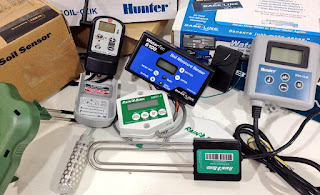Outdoor watering restrictions are one of the more common methods in Florida for curtailing irrigation. Most of the water management districts in the state recommend limiting irrigation during some portion of the year, usually during Florida’s dry season (November - April). Recently, UF-ABE alum Dr. Mackenzie Boyer published research which analyzes the effectiveness of irrigation restrictions - Water Conservation Benefits of Long-Term Residential Irrigation Restrictions in Southwest Florida. Read on for a selection of excerpts.
 |
| Dr. Mackenzie Boyer in presentation mode |
Residential irrigation watering restrictions are often a standard water
conservation tool for US utilities, especially in the Southeast and
Southwest, where water resources are particularly limited and there
have been prolonged droughts. Water restrictions take various forms
throughout the United States. Most residential ordinances ban irrigating
during the hottest daytime hours (when irrigation water can be lost to
evaporation before it has a chance to be used by plants) and limit
homes to specific watering days. Some restrictions are voluntary,
while others are mandatory. Many have exceptions for newly
planted landscapes or handwatering. Despite the prevalence of water
restrictions, there is little published research on their effectiveness, and
research is generally limited to short durations or utility-wide averages
conservation tool for US utilities, especially in the Southeast and
Southwest, where water resources are particularly limited and there
have been prolonged droughts. Water restrictions take various forms
throughout the United States. Most residential ordinances ban irrigating
during the hottest daytime hours (when irrigation water can be lost to
evaporation before it has a chance to be used by plants) and limit
homes to specific watering days. Some restrictions are voluntary,
while others are mandatory. Many have exceptions for newly
planted landscapes or handwatering. Despite the prevalence of water
restrictions, there is little published research on their effectiveness, and
research is generally limited to short durations or utility-wide averages
 |
| Study area in Southwest Florida |
Discussion
Figures 5 and 6 show both the benefits and shortcomings of
day-of-the-week water restrictions to reduce irrigation demand. The
figures show the mean (Figure 5) and median (Figure 6) monthly
irrigation demand and irrigation required of the four groups.
It is clear from the magnitude of the irrigation demand that the high
group irrigated regularly (3.2–5.6 in./month under two days/week
restrictions), whereas the occasional group irrigated little if at all
(<0.3 in./month). Therefore, the high group had a greater potential
for conserving. Irrigation demand for high irrigators was 10.2 in./year
lower under one day/week restrictions compared with two days/week
restrictions, whereas occasional irrigators’ irrigation was 0.3 in./year
higher (Table 2). Day-of-the-week restrictions were successful in
reducing irrigation demand of the highest users, but they may also
encourage some customers to irrigate.
day-of-the-week water restrictions to reduce irrigation demand. The
figures show the mean (Figure 5) and median (Figure 6) monthly
irrigation demand and irrigation required of the four groups.
It is clear from the magnitude of the irrigation demand that the high
group irrigated regularly (3.2–5.6 in./month under two days/week
restrictions), whereas the occasional group irrigated little if at all
(<0.3 in./month). Therefore, the high group had a greater potential
for conserving. Irrigation demand for high irrigators was 10.2 in./year
lower under one day/week restrictions compared with two days/week
restrictions, whereas occasional irrigators’ irrigation was 0.3 in./year
higher (Table 2). Day-of-the-week restrictions were successful in
reducing irrigation demand of the highest users, but they may also
encourage some customers to irrigate.
 |
| Mean and median irrigation demand/required |
Long-term water restrictions that periodically reduced irrigation from
two days to one day/week during the study period of 1998 through
2010 coincided with lower irrigation demand in southwest Florida.
Annual irrigation demand was 13% lower (11.3 in./year under two
days/ week restrictions to 9.8 in./year under one day/week restrictions),
while annual irrigation required was 3% higher (25.0 in./year under
two days/week restrictions and 25.7 in./year under one day/week
restrictions) during the period of the more stringent restrictions.
Throughout the region, customers’ irrigation demand tended to be
much lower than the irrigation required, classifying the region as a
whole as one of deficit irrigators. As a group, high irrigators’
(defined as having annual irrigation demand that exceeded the
irrigation required) irrigation demand as a depth was 20% lower
under the more stringent conditions, indicating that those who
irrigated most had the most potential for conservation. Additional
conservation potential existed for high irrigators, for which the
irrigation demand was still 56% above irrigation required under
one day/week restrictions. The primary focus of this study was
long-term water restrictions, but the brief ban on irrigation in
Tampa in April and May 2009 resulted in a substantially lower
irrigation demand as well.
two days to one day/week during the study period of 1998 through
2010 coincided with lower irrigation demand in southwest Florida.
Annual irrigation demand was 13% lower (11.3 in./year under two
days/ week restrictions to 9.8 in./year under one day/week restrictions),
while annual irrigation required was 3% higher (25.0 in./year under
two days/week restrictions and 25.7 in./year under one day/week
restrictions) during the period of the more stringent restrictions.
Throughout the region, customers’ irrigation demand tended to be
much lower than the irrigation required, classifying the region as a
whole as one of deficit irrigators. As a group, high irrigators’
(defined as having annual irrigation demand that exceeded the
irrigation required) irrigation demand as a depth was 20% lower
under the more stringent conditions, indicating that those who
irrigated most had the most potential for conservation. Additional
conservation potential existed for high irrigators, for which the
irrigation demand was still 56% above irrigation required under
one day/week restrictions. The primary focus of this study was
long-term water restrictions, but the brief ban on irrigation in
Tampa in April and May 2009 resulted in a substantially lower
irrigation demand as well.
Acknowledgment
The authors would like to thank the Southwest Florida Water
Management District and Tampa Bay Water for funding this research.
Management District and Tampa Bay Water for funding this research.







